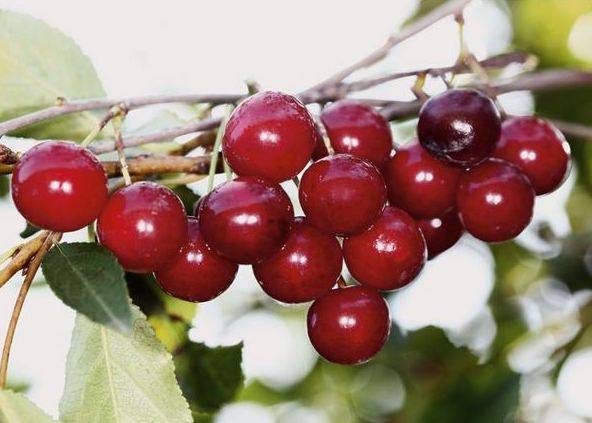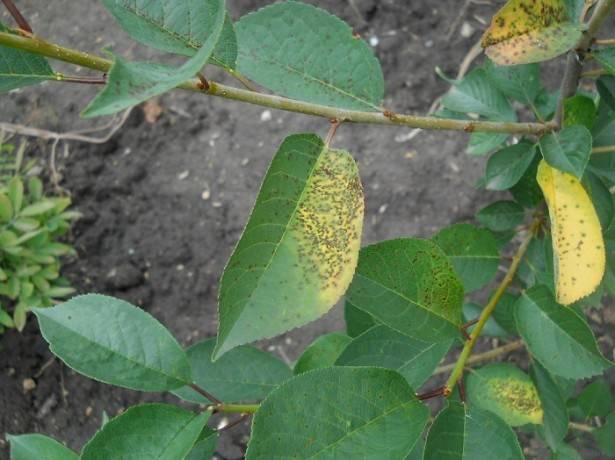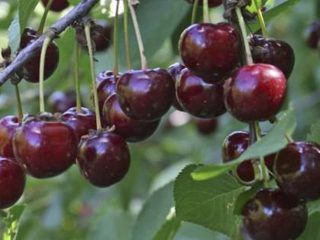Content
There are only 5 types of edible cherries: common, steppe, cherry, felt and Magaleb. Each has its own characteristics. For example, steppe cherry grows as a multi-stemmed bush and can withstand severe frosts. This is what is cultivated in cold regions.
History of selection
The Bolotovskaya variety was created by amateur gardener A.I. Bolotov through selective selection of steppe cherry seedlings. This cultivar was then tested at the Sverdlovsk Horticulture Station. With the participation of N.I. Gvozdyukova and M.G. Isakova, a study of the variety was carried out. The selected seedling was submitted to the State Variety Test. Since 1989, the Bolotovskaya variety has been recommended for cultivation in the Ural region.
Description of culture
Bolotovskaya cherry forms a spreading bush up to 1.8 m high. The crown is of medium density, with drooping branches, the buds are located at an angle to the shoot.An oval elongated leaf with a triangular base and a sharp tip along the edge, jagged, slightly wavy. It is painted green, glossy, straight. The stalk is about 8 mm long from the top with anthocyanin coloration.
The flowers are white, with freely arranged petals, collected in 5 pieces. on bouquet branches and last year's shoots. The fruits are dark red, wide-round, with a medium funnel. Their weight reaches 3-4 g, which is considered a good indicator for steppe cherries. The pulp and juice of Bolotovskaya are red.
The sweet and sour taste of the berries is considered satisfactory. It is rated 3.8 points. The cherries are well attached to the stem. The berries are not prone to cracking or shedding. The stone is brown, small (0.17 g), easily separated from the pulp.
The Bolotovskaya variety showed itself well when grown in the Ural region.
Characteristics
All the characteristics of the Bolotovskaya cherry variety listed below are fully manifested only in the region recommended for cultivation. In the south, the crop will suffer from the heat, and in the north it will freeze.
Drought resistance, winter hardiness
The Bolotovskaya steppe cherry variety is quite drought-resistant. In rainy summers, it does not need watering at all, although it requires mandatory autumn moisture recharging.
The winter hardiness of the Bolotovskaya variety is high. Even if the cherry is frozen, it will quickly recover.
Pollination, flowering period and ripening time
Bolotovskaya cherry has high self-fertility. It is capable of producing a good harvest when planted alone, and is pollinated by any variety.
Bolotovskaya blooms in the mid-late period - the buds bloom by the end of May or even the beginning of June. This allows them to escape possible return frosts. Fruiting is extended and begins in the first ten days of August. The Bolotovskaya variety is classified as a medium-late ripening cherry.
Productivity, fruiting
Bolotovskaya cherry bears fruit regularly. It gives an excellent harvest starting from the third year after planting. It should be noted that the variety is capable of bearing fruit for 30 years. Of course, this applies to self-rooted plants. You should also not neglect fertilizing and anti-aging trimmings - without them, even Bolotovskaya grown from a seed or shoots will not be productive for so long.
Despite its modest size, the variety produces 70-80 centners per hectare. Due to its high yield, Bolotovskaya cherries are used not only in private but also in industrial gardening.
Area of application of berries
The Bolotovskaya variety is a cherry whose fruits have a technical purpose. Its taste is mediocre, only 3.8 points, eating berries straight from the tree is a small pleasure. But jams, juices, and compotes turn out good.
Resistance to diseases and pests
The Bolotovskaya variety is susceptible to fungal diseases, in particular moniliosis and coccomycosis. But the cherry crop is rarely affected by typical pests. Only in some years does Bolotovskaya get pestered by slimy sawfly and aphids.
Advantages and disadvantages
When it comes to the advantages and disadvantages of a variety, one should not forget about its purpose.So, Bolotovskaya cherry is a commercial crop; it makes no sense to expect tasty sweet berries from it. Here, productivity and the content of a large number of useful substances in the fruits come to the fore. The advantages of Bolotovskaya include:
- High frost resistance.
- Self-fertility.
- Drought resistance.
- High yield.
- The bush is small in size, which makes it easy to collect fruits.
- Bolotovskaya berries are not prone to shedding.
- The fruits do not crack.
- Late flowering, which allows the variety to avoid return frosts.
- Regular fruiting.
- The berries are removed with a dry separation.
- For steppe cherries, the Bolotovskaya variety has large fruits.
- Low susceptibility to typical cherry pests.
Disadvantages of the variety:
- The fruits are of mediocre taste, sour.
- Susceptibility to fungal diseases.
- Bolotovskaya can not be grown in all regions.
Landing Features
Variety Bolotovskaya – steppe cherry. This is where all its features and requirements come from. Bolotovskaya is not capricious and easy to care for, you just need to choose the right time and place of planting.
Recommended timing
It is not recommended to plant Bolotovskaya cherries in early spring. It is placed on the site no earlier than the soil has warmed up well. This usually happens in May, and in the north of the Ural region sometimes even in early June.
Choosing a suitable location
Like all cherries, steppe cherries do not like wetlands and lowlands. You need to choose an open space or a small hill. It is important to cover it from cold winds with a fence, building wall or other trees.
The lighting should be good - with a lack of sunlight, the Bolotovskaya cherry will bear fruit, but the lower berries will begin to rot before reaching full ripeness, and the upper ones will quickly dry out.They simply won't start in the shade.
Bolotovskaya steppe cherry prefers carbonate soils. In soils other than humus, dolomite flour must be added.
What crops can and cannot be planted next to cherries?
The best neighbors for the Bolotovskaya variety will be other cherries. You cannot plant other rapidly growing shrubs next to it - the steppe grass itself produces a lot of shoots. Then you will have to deal with the thickets of intertwined roots of different cultures.
Even after the Bolotovskaya cherry takes root well, it is not recommended to plant ground covers under it. To reduce the amount of growth and better supply of oxygen, the tree trunk circle must be constantly loosened.
Selection and preparation of planting material
Steppe cherry reproduces well by root shoots. It is the own-rooted seedlings that should be given preference when purchasing - they are less capricious and more durable. In order not to make a mistake with the variety, it is better to buy planting material in nurseries or large garden centers.
The cherry root system should be well developed, the bark intact, and the branches elastic. Before planting, container seedlings are watered. The exposed root system is soaked in water for at least 3 hours. If the cherry was purchased at an exhibition or its root has dried out, this period is increased to a day.
Landing algorithm
Since the Bolotovskaya cherry variety needs to be planted no earlier than the soil has warmed up, it is not necessary to dig a planting hole in the fall.Fertile soil is prepared in this way: the top fertile layer of soil is mixed with approximately 500 g of dolomite flour, a bucket of humus and 50 g of phosphate fertilizers.
The hole is dug 2-3 weeks before planting. Its size should be approximately 60x60x60 cm. Next comes the actual planting:
- The seedling is installed in the center of the hole.
- Its root is gradually covered with a fertile mixture and carefully compacted. This will help prevent voids from forming. The root collar should rise above the edge of the planting hole by about 5 cm.
- A side is formed around the trunk circle.
- The bush is watered with 2-3 buckets of water.
Subsequent care of the crop
In the first season after planting, the Bolotovskaya seedling is regularly watered, the soil is loosened, and weeds are pulled out. In subsequent years, the soil is moistened only if there is no precipitation during the month and in the fall.
When feeding with organic matter (ash and humus), it is necessary to add additional doses of phosphorus - steppe cherries need it more than ordinary cherries. When using mineral fertilizers, nitrogen is applied in the spring, potassium and phosphorus in the fall.
The soil under the cherry tree is regularly loosened and freed from weed. Sanitary and formative pruning is carried out annually. From the age of 15, they begin to rejuvenate the bush - they gradually remove the old skeletal branches.
For the winter, the Bolotovskaya cherry does not require shelter - steppe cherry trees can withstand frost down to -50⁰ C. The bush is protected from hares by installing a special net - wrapping it with burlap or tying straw around numerous stems is inconvenient.
Diseases and pests, methods of control and prevention
The Bolotovskaya cherry variety has high resistance to pests and low resistance to fungal diseases. The main problems and ways to solve them are given in the table.
Diseases, pests | Symptoms | Treatment | Prevention |
Coccomycosis | Dots appear on the leaf blades, then they grow and turn into holes. Leaves turn yellow and fall off | During bud break, treatment with a copper-containing preparation, after leaf fall - with iron sulfate | Removal of fallen leaves, preventive treatments, regular pruning |
Moniliosis | First, young vegetative organs dry out, then entire branches. The bark becomes cracked when the disease is advanced | Removing the affected wood with part of the healthy tissue. Then treatment with preparations containing copper | See coccomycosis |
Cherry aphid | Small winged insects literally cling to young leaves and shoots, sucking cell sap from them. Vegetative organs become deformed and become sticky to the touch | If there are few aphids, the cherries are sprayed with a solution of laundry soap. In case of severe damage, use appropriate insecticides | Destruction of anthills. Regular pruning |
Cherry slimy sawfly | Leech-like larvae chew leaves | Treatment with insecticides, for example, Aktelik | Regular pruning, preventive treatment with insecticides |
Conclusion
Although Bolotovskaya cherry is a technical variety, it grows well in the cool climate of the Ural region. You can make excellent jam, compote or juice from the berries. The variety is suitable for intensive cultivation and is grown on large farms in the Chelyabinsk and Sverdlovsk regions.





















Good afternoon. The fact that it can withstand temperatures down to minus 50 degrees is an exaggeration. All the tops above the snow cover froze last winter. The temperature was 40-50 degrees. In the previous winter, they buried it in snow - it overwintered normally.